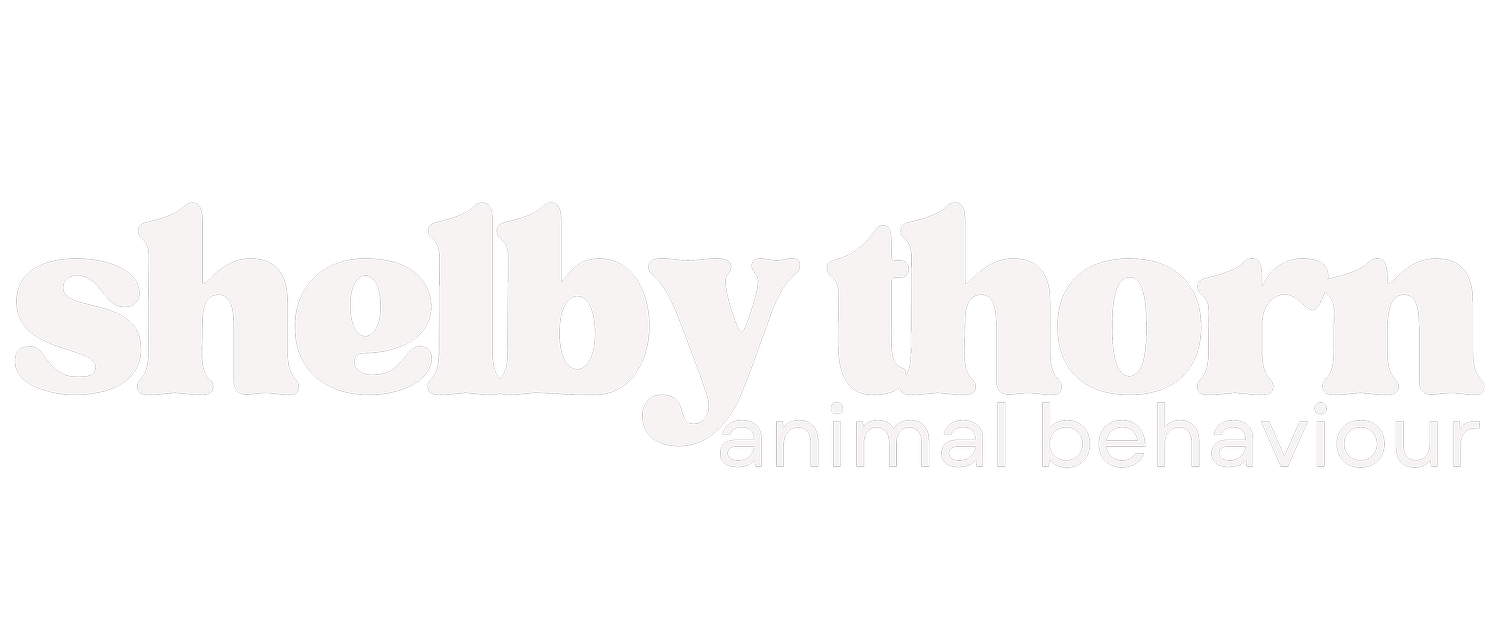Positive Vibes, Positive Training: Why a Force-Free Approach Matters
I often get asked by clients how they should punish their dog, and they are often left scratching their heads when I tell them we actually don’t want to intentionally implement punishers in our dog’s worlds. I often advertise our training here at Shelby Thorn Animal Behaviour is ‘positive vibes only’ - let’s talk about what this actually means.
We avoid using the term “positive reinforcement only” because, as you can imagine, it’s pretty much impossible to exclusively rely on just one quadrant of behaviour modification. Our approach to training is holistic—we take into account the animal's health, nutrition, physical setting, antecedent arrangements, and yes, we use positive reinforcement, along with methods like differential reinforcement of alternative behaviours, all ranked according to what’s best for the individual dog.
So, why do we engage with dogs in this way? Well, there are several key reasons:
1. It communicates what you want a dog to do, not just what you don’t want them to do.
When we mark and reinforce desirable behaviours, we’re strengthening those behaviours and encouraging them to happen more often. If your dog is pulling on the leash, for example, rather than simply correcting or punishing them, you can teach them to walk nicely by setting up calm walking, and then reinforcing it. By guiding or forcing them into certain positions (like using leash pressure), you’re not allowing the dog to practice the behaviour itself. This can cause confusion and even lead to stress or fear of handling. When we lure dogs, we’re giving them the opportunity to make the right choice voluntarily, promoting real learning without the fallout that comes from more forceful methods, and encouraging them to make the choice to walk nicely, which is where the learning happens!
2. Punishment creates unintended consequences.
Dogs are like sponges—they soak up their environment, and they’re constantly learning, often without us realising it. When punishment is used, the dog can associate negative experiences with things they didn’t even do wrong. Let’s say you’re walking your dog and they’re pulling on the leash. You might give a correction and yell “Oi!” but if at that same moment a cat enters the picture, your dog might link the cat to the negative experience, not the pulling. This can result in an irrational fear of cats, which is the last thing we want.
3. It decreases the likelihood of aggression.
Dogs use aggression when they feel they have no other options to communicate they’re uncomfortable. By training in a force-free way, we remove the stress and anxiety that can lead dogs to feel cornered, which in turn can reduce the chances of them resorting to aggression use as a way of expressing fear or frustration. Dogs that feel safe and understood are much less likely to escalate into aggressive behaviours.
4. It reduces stress for both the dog and the human.
When you use positive reinforcement, your dog understands exactly what’s expected of them. This clarity leads to noticeable improvements in their behaviour. And for you, as the owner, it’s a huge relief to see your dog succeeding. No more guessing games or constantly correcting unwanted behaviours. Training becomes a positive, rewarding experience for both of you.
For the dog, the lack of unpredictable punishment means they can relax and trust you. They won’t feel like they’re constantly “walking on eggshells,” unsure of when or why they might get punished. A stress-free dog is a happy, well-adjusted dog—and a happy dog makes for a happier human too!
5. It helps create a predictable, trusting relationship that leads to an anxiety-free life.
Dogs are creatures of habit, and when they know what to expect from their interactions with us, they become more confident and secure. Positive reinforcement fosters a strong, trust-based relationship. This predictability helps relieve anxiety in your dog, as they can anticipate positive outcomes when they engage with you or behave in certain ways. And with this kind of relationship, your training goals become not just achievable, but sustainable.
6. It’s backed by science and endorsed by experts.
The importance of positive, reward-based training is widely recognised. The Australian Veterinary Association, the Association of Pet Dog Trainers (APDT), Pet Professional Guild of Australia (PPGA) and many other internationally respected organisations advocate for force-free methods. Dog training is an evolving science, and the evidence is clear—training that prioritises the animal's well-being leads to better, more effective results.
For more information, check out resources from the Australian Veterinary Association, Association of Pet Dog Trainers, or the International Association of Animal Behavior Consultants.
So there you have it!
Work towards being a proactive dog handler! Instead of relying on punishment, consider practicing reliable cues such as ‘Leave it’, set up your environment for success, redirect unwanted behaviour to something more desirable and reinforce desirable behaviours as they occur. We’re so quick to say no but how often are we saying ‘Yes!’.

